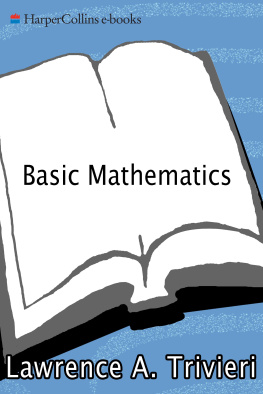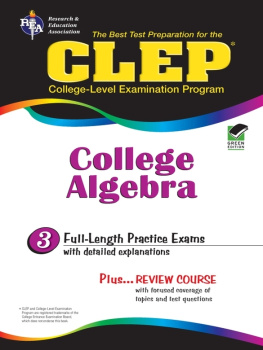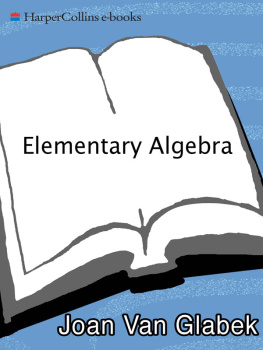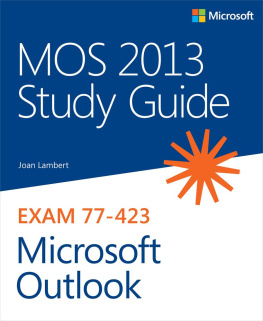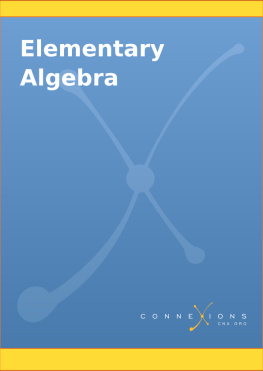Elementary Algebra
2nd Edition
Joan Van Glabek, Ph.D.
Edison College
Naples, FL
Contributing Editor
John Niman, Ph.D.
Hunter College of the City University of New York
New York, NY

ELEMENTARY ALGEBRA. Copyright 1991, 2006 by HarperCollins Publishers. All rights reserved under International and Pan-American Copyright Conventions. By payment of the required fees, you have been granted the nonexclusive, nontransferable right to access and read the text of this e-book on-screen. No part of this text may be reproduced, transmitted, downloaded, decompiled, reverse-engineered, or stored in or introduced into any information storage and retrieval system, in any form or by any means, whether electronic or mechanical, now known or hereinafter invented, without the express written permission of HarperCollins e-books.
An American BookWorks Corporation Production
Library of Congress Cataloging-in-Publication Data
Van Glabek, Joan.
Elementary algebra / Joan Van Glabek ; contributing editor, John Niman. 2nd ed.
p. cm.
ISBN: 978-0-06-088148-1
ISBN-10: 0-06-088148-8
1. AlgebraProblems, exercises, etc. I. Niman, John. II. Title.
QA157.V355 2006
512-dc22 2006051734
EPub Edition SEPTEMPER 2011 ISBN: 978-0-06-211502-7
06 07 08 09 10 CW 10 9 8 7 6 5 4 3 2 1
Contents
Number Systems and the Basics
Solving Linear Equations and Inequalities
Graphing Linear Equations
Systems of Linear Equations
Exponents and Polynomials
Factoring
Rational Expressions
Radical Expressions
Quadratic Equations
This book presents the material for a firm foundation in elementary algebra. There are many worked examples with enough steps to help the beginning algebra student follow the work from one step to the next step. As you progress through the material, if you are able to skip a step or two, great! A set of exercises and answers appear at the end of each chapter to allow the reader to practice and receive immediate feedback. Keep pencil and paper handyreading and working through this book will give you the skills necessary to continue your study of mathematics.
Joan Van Glabek, Ph.D.
Number Systems and the Basics
T his chapter contains a review of arithmetic topics and extends these concepts to algebra. You may be able to skip part (or all) of this chapter if your mathematics background is current. Consider working the problems at the end of the chapter as a pretest. If you can work the problems at the end of the chapter correctly, move ahead to Chapter 2.
1.1 NOTATION AND ORDER OF OPERATIONS
The four basic operations used in arithmeticaddition, subtraction, multiplication, and divisionare also used in algebra. This section reviews some language and symbols from arithmetic and describes the uses of some of these familiar symbols in algebra. You may want to highlight words that are unfamiliar and refer back to this section as necessary. Variables (letters like x and y) will be used in some of the exercises to represent numbers.
THE BASIC OPERATIONS
The following table reviews some of the language and symbols associated with addition, subtraction, multiplication, and division:
| Operation | Symbol | Example | English Phrases |
| Addition | + | 4 + 6 | The sum of 4 and 6
4 plus 6
4 added to 6 |
| Subtraction | - | 5 - 2 | The difference of 5 and 2
5 minus 2
5 less 2
2 subtracted from 5 |
| Multiplication | 3 2 | The product of 3 and 2
3 times 2 |
| Division | 6 2 | The quotient of 6 and 2
6 divided by 2
2 into 6 |
We avoid the use of the symbol x for multiplication in algebra to prevent confusion between the variable x and the symbol x to imply multiplication. Other ways to show multiplication in algebra may involve the use of parentheses.
| Multiplication with Numbers | Multiplication with Variables |
| 3(4) | a(b ) |
| (3)4 | (a)b |
| (3)(4) | (a)(b) |
| No numerical equivalent | ab |
Multiplication is implied in the following cases: when there is no symbol between two variables; when there is no symbol between a variable and a number; and when there is no symbol between a variable and a parenthesis. You cannot use this convention when multiplying two numbers, however. 34 means thirty-four, never 3 times 4.
Likewise, there are several ways to imply division.
| Division with Numbers | Division with Variables |
| 62 | ab |
 |  |
 |  |
| 6/2 | a/b |
SIMPLIFYING
In arithmetic, many problems contain only one of the four basic operations of addition, subtraction, multiplication, and division. In algebra, there will often be more than one operation involved. Thus, you will often see directions such as simplify, which means you should perform any indicated operations.
GROUPING SYMBOLS
The following symbols are used to group numbers together:
| Symbols | Name of the Symbols |
| ( ) | Parentheses |
| [ ] | Brackets |
| { } | Braces |
| | | | Absolute value bars |
 | Fraction bar |
When simplifying, perform operations inside parentheses, brackets, braces, and absolute value bars first. The fraction bar as a grouping symbol means to simplify above and below the bar separately.
Exercise 1.1
Simplify:
a) (4 + 8)
b) [10-5 ]
c) 
d) (7 - 3) + (6 - 4)
Solution 1.1
| a) (4 + 8) = (12) = 12 | Add inside the parentheses. |
| b) [10-5 ] = [5] = 5 | Subtract inside the brackets. |
 |  |
| d)(7 3) + (6 4) = (4) + (2) | Simplify within each set of parentheses. |
| = 6 | Simplify by adding. |
LANGUAGE
The numbers and/or variables involved in the four basic operations have names, as given in the following table:






